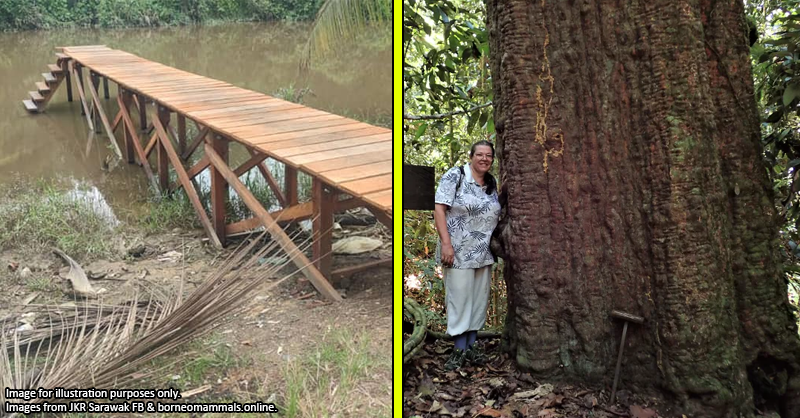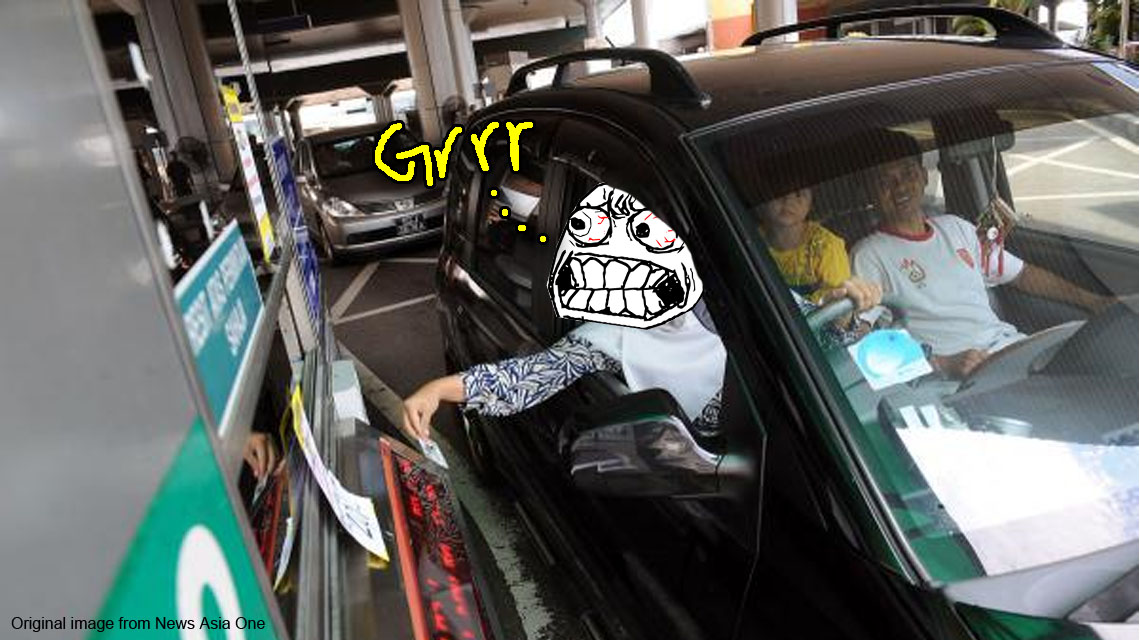Building more SMART tunnels will reduce floods, but here’s why it’s not possible. [UPDATED]
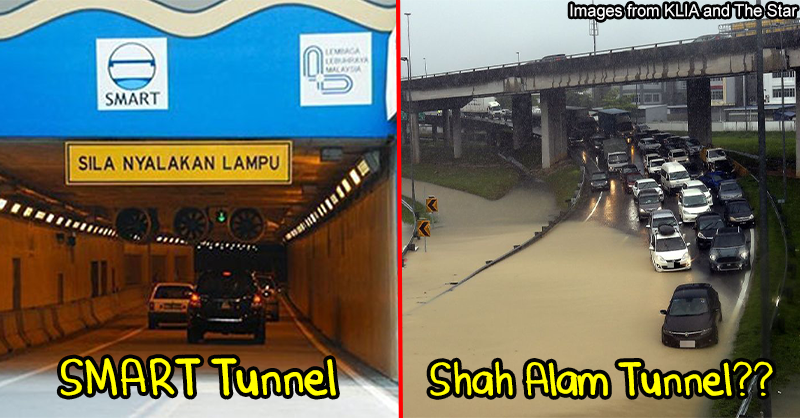
- 892Shares
- Facebook812
- Twitter17
- LinkedIn15
- Email15
- WhatsApp33
[Update: 5 February 2022]
So, remember how we talked about some of the reasons why the gomen wouldn’t be able to just simply build SMART Tunnels everywhere?
Yeah, well after much evian water drinking deliberation, the Central Disaster Management Committee (CDMC) agreed to NADMA’s proposal of eight new strategic disaster-management methods; one of which is the building of more SMART Tunnels in Shah Alam and other major cities!!! YAY!!
And of course, like we mentioned in the original article, one of the reasons why the gomen probably didn’t just do this in the first place was because it’s EXPENSIVE AF. In fact, our current PM even acknowledged that this new project might cost billions, and asked all the relevant ministries/agencies to take a 5% cut off their expenditures just for these new efforts.

Anyways… since this decision was just made, we won’t really know when the projects will actually start. But at least with this new decision being made, there’s hope that we might be able to prevent another catastrophic event like the recent floods from happening again.
[End of update: Dunno what we talking about? Read the rest of the article la!]
Malaysian social media has been abuzz lately with the very recent catastrophic flooding. And if there’s anything that we’ve learned from this and past incidents like Kelantan 2014 (which one of our writers was stuck in, btw), it’s that our country is no stranger to flooding. However, while the other areas were basically starting to sink, the flood situation in the Klang Valley area wasn’t as severe. But it hasn’t always been that way.

And the only person infrastructure that we can thank for this is our very own award-winning SMART Tunnel, which actually prevented KL City from sinking further during the flood. But how exactly did a single tunnel manage to prevent a whole city from sinking?
SMART isn’t just to prevent traffic jams, it’s also to prevent floods.

As you may already know, SMART doesn’t actually mean “smart”. (duh.) It’s an abbreviation for ‘Stormwater Management And Road Tunnel’ which means it functions as both a storm drain and a road for cars! Because why have just one function for your giant tunnel when you can have two?
Contrary to popular belief, the SMART Tunnel wasn’t just made for KL-ites to avoid jamming their way to the KL city area; it was also made to reduce the floods in KL. In fact, the whole reason why the SMART Tunnel idea was born in the first place was because the gomen was looking for a way to stop the city center from flooding each time a flood occurred.
So, here’s how the SMART Tunnel works…
The SMART Tunnel helps to contain water… temporarily.
(Psst. We wrote another article in the past explaining this in detail, you can click here to read it.)
Since the SMART Tunnel operates as both a storm drain and a motorway tunnel, it doesn’t always function as a storm drain. The SMART Tunnel has 4 different modes that operate according to the severity of the flood:
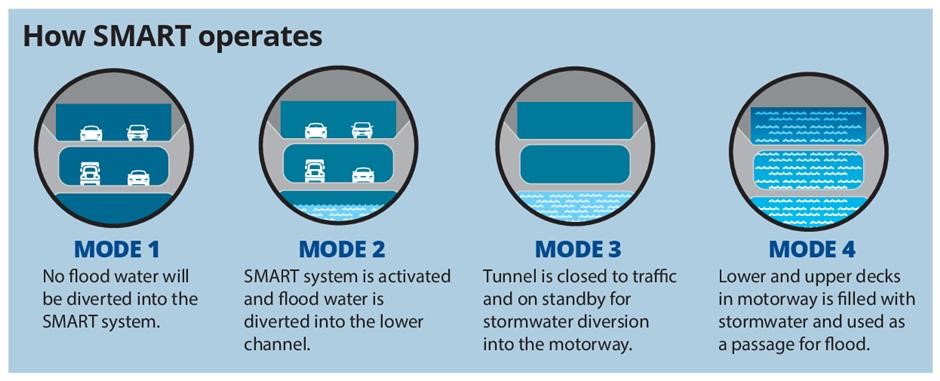
- Mode 1: No Flood
Since there is usually no flood, most of the time, the SMART Tunnel operates in Mode 1. During this mode, the SMART Tunnel only functions as an ordinary motorway tunnel for vehicles.
- Mode 2: Moderate Flood
When there is a slight flood, the SMART system activates and the flood water is diverted into the stormwater tunnel. The motorway tunnel will still be opened to traffic usage.
- Mode 3: Heavy Flood
When a major storm begins to occur, The SMART Tunnel is closed from traffic usage and any remaining cars in the tunnel will be evacuated in preparation for entering Mode 4. However, if the storm were to stop early, the motorway tunnel will be reopened for traffic usage within the next few hours.
- Mode 4: Severe Flood
However, if the storm does prolong, the motorway tunnel will begin to fill with floodwater, up until it is no longer able to contain any more water. This mode has only been in activation about 8 times thus far.
And that’s the reason why they close the tunnel and block cars from entering during the storm, because entering the SMART Tunnel in Mode 4 might really end up being catastrophic for your car. Just sayin’. But what happens to the stormwater that flows into the SMART Tunnel?
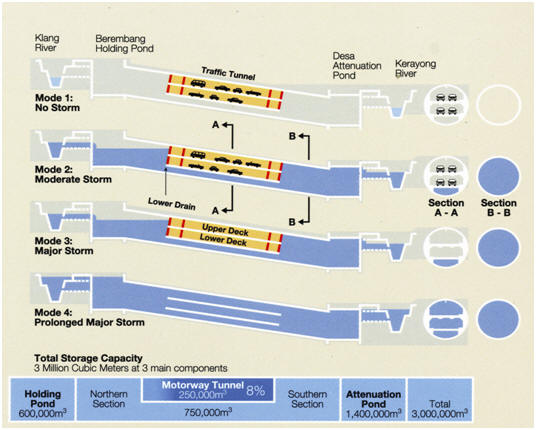
Here’s the flow of it: The stormwater that enters the SMART Tunnel makes its way down to the Taman Desa Retention Pond, where it’s held before flowing down to the Kerayong River. The Kerayong River then connects back to the Klang River, which then flows into the Straits of Malacca, discharging the water back into the ocean.
But despite the SMART Tunnel’s ability to successfully channel water out of KL, there’s currently only ONE of its kind in the entire country. And we found out the actual reason why.
We can’t build SMART Tunnels everywhere because… expensive.

When news about the SMART Tunnel diverting water out of KL broke, many Malaysians began questioning why there weren’t more SMART Tunnels being built around the country. So, we dug a little deeper (heh) and interviewed Robert, who was one of the on-site construction managers of the SMART Tunnel development project.
According to Robert, one of the biggest reasons why we aren’t able to build more SMART Tunnels is because it’s a huge cost.
“It’s also not just about development costs, but also maintenance costs. SMART Tunnel collects such a hefty toll to supplement the costs of maintaining the SMART Tunnel.” – Robert, to CILISOS.
Apparently the SMART Tunnel construction costs were about 1.88 billion ringgit in total, which does kind of explain the major hesitation on the developing end?? Although if we were to factor in the probable costs of much-needed maintenance as well, we can guess that the amount of money put into a single SMART Tunnel would probably be enough to fund a number of other flood control methods instead.
And even though most of these costs are most likely being covered through things like our taxes, the cost might also ultimately borne by the road users themselves (which is most probably why it’s so expensive 😅) So, more smart tunnels = more expensive tolls, perhaps?
But cost-issues aside, Robert also noted that another reason why we can’t build SMART Tunnels everywhere is because…
There are also a ton(nel) of issues with location and logistics.

Sorry folks! The truth is, even if our gomen wanted and had the capital to build more SMART Tunnels, it probably can’t be achieved everywhere. According to Robert, the location of the tunnel would be the greatest factor of all.
First, the ground elevation of the area would need to be large enough to accommodate the sheer size of the tunnel, which is about 13.2 meters wide in diameter. With that said, Robert mentioned that the best places to put a SMART Tunnel would be in the bigger cities, which are more prone to flash floods. He also suggested that for areas out of the city, a good alternative would be to cut an open drain, or to have a proper drainage system.
“With the exception of the East Coast, which has floods caused by the monsoons, we usually don’t have much of a problem with actual floods in the other states. They’re all mostly flash floods, which happens is because there is no proper drainage maintenance.” – Robert.
However, even if they were able to fit a SMART Tunnel in the area, it would need to connect to a nearby retention pond, and eventually river, to be able to siphon all the water out. And if there were too many tunnels discharging their water into the same river, it might end up overflowing and causing… another flood.
The SMART Tunnel can manage the floods, but it can’t solve them.
Ultimately, as successful as our SMART Tunnel was, it can only serve to reduce the effects of the flood by a certain amount, not solve the entire flooding issue.
Like Robert mentioned earlier, most of the floods that we have in this country are flash floods, which are caused by a number of reasons; one of which is due to a lack of proper drain maintenance. This then boils down to the question of: How exactly can we completely get rid of floods in the country?
And the truth is, we can’t. But at the very least we can learn to manage them, with the right amount of planning, restructuring, and err… cleaning. After all, there’s always a light at the end of the tunnel.
- 892Shares
- Facebook812
- Twitter17
- LinkedIn15
- Email15
- WhatsApp33


